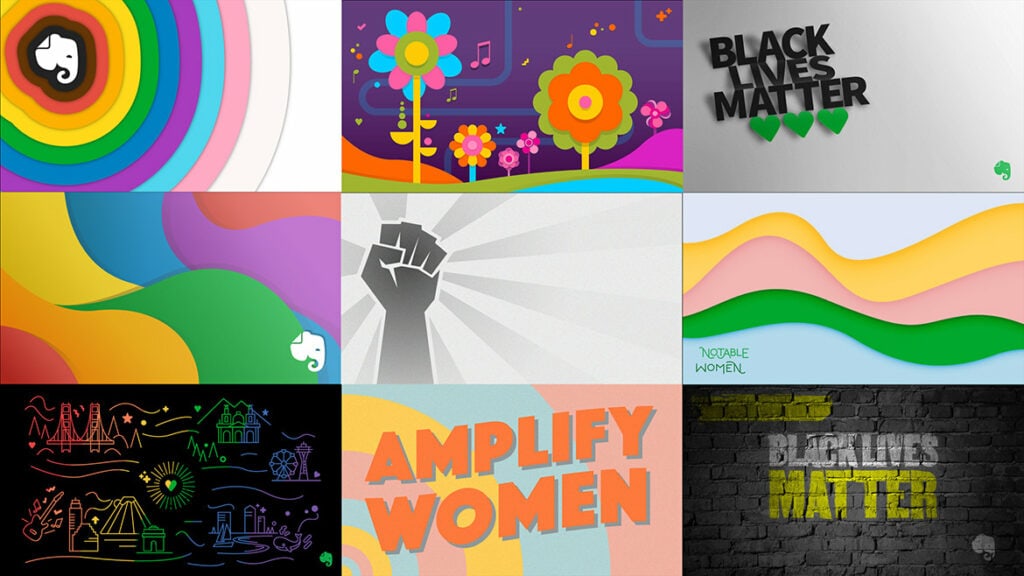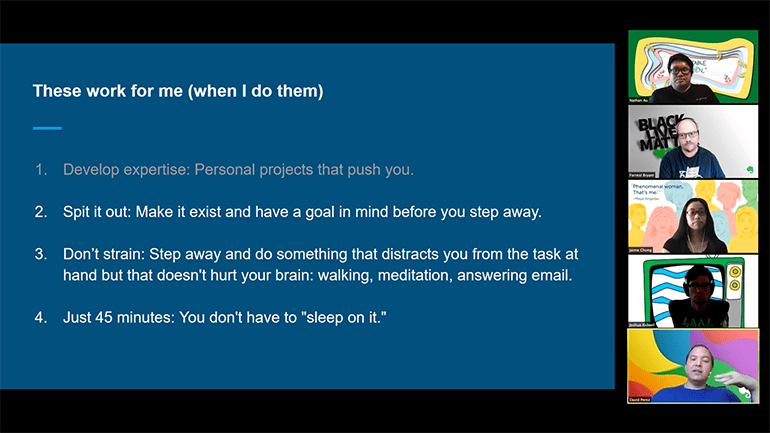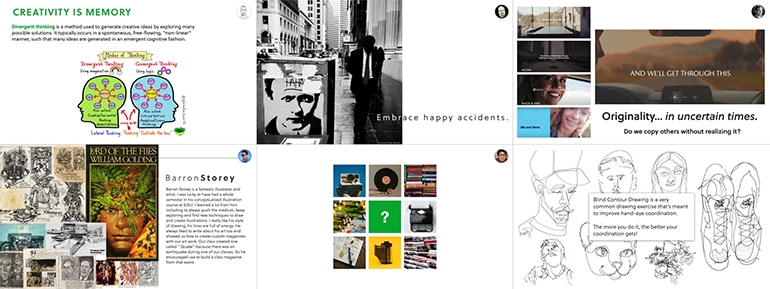
This post originally appeared on LinkedIn
You’ve seen the sight so often it’s become a cliché. There are your teammates, the people you used to sit alongside for 40–60 hours per week, reduced to a grid of low-resolution heads, staring back at you. They robotically repeat the mantras of the new Zoom-based workforce: You’re on mute… Sorry, go ahead… Can you see my screen? The novelty has given way to monotony and stress. The Brady Bunch and Hollywood Squares quips became stale weeks ago. And maybe your team has, too.
This is a problem, particularly for creatives who need regular doses of fresh inspiration to do their jobs.
In some ways, remote work can liberate a writer or designer. Without the noise pollution and constant “drive-by” requests that plague open office spaces, many of us can finally tackle deep work (at least until the kids get bored). Yet we’ve also lost the most rewarding parts of the workday. There’s no spontaneous collaboration. No collective energy sparking unexpected tangents. No serendipity.
Don’t stagnate; generate!
When a team’s only interactions are in status meetings, the days stagnate, and so does our work. Call them whatever you will: stand-ups, check-ins, syncs, confabs… they all suck the life out of a creative soul. Friday afternoon “beer chat” meetings can be fun—who wouldn’t like an unstructured chance to let your hair down? But they are inadequate, precisely because they lack direction. They become one more damn meeting, and at the worst time, when everyone wants desperately to log off but is too polite to say so. At the other extreme, 1-on-1s can be insightful, but they exclude the team, are awkward over video and, again, too often feel like a chore.
What we need is a creative generator: an alternative source for the energy and mutual support we had in the office. How can we build up that energy? How can we maintain a creative culture when the raw material of creativity is so scarce?
For my team at Evernote, the answer is simple: sprinkle deep, meaningful team-wide interactions throughout the week. These are social gatherings with purpose—we use them to critique work, share ideas, recognize achievements, discuss craft, and spur each other to think in novel ways. We carve out spaces where creatives can be themselves, keeping things lively and lighthearted, and dive deep into what it means to be who we are. In doing so, we make each other better creatives and a tighter, stronger team.

Making time for creativity: How team culture defines our week
Evernote’s Creative Studio team is small, eight people in total. But we’re responsible for a vast array of deliverables. We don’t have the luxury of specialization or deep process. Projects move fast and often involve all of us, so we have to work together, seamlessly. Team culture moments spread throughout the week provide the glue.
Monday mornings begin with a team award, recognizing one colleague for outstanding work in the previous week. Whoever wins the award gets to choose the next winner. This tiny ritual boosts confidence and morale, but it also does something more. It encourages everyone on the team to pay attention to each other’s projects, acknowledge the hard work of their peers, and celebrate our wins.
As the week progresses, a series of lightweight creative reviews keep us focused on each other. We might look at anything, at any stage, from a hasty pencil sketch to a nearly finished deliverable. The feedback can range from broad directional input to pixel and comma tweaks. Even the occasional personal project is welcome, because we recognize that being creative doesn’t stop at five o’clock. Everything we create can potentially spark a breakthrough at work, in ourselves, or in each other.

Additional opportunities to bond and grow come in our weekly “Film Festival” meeting and the “Thought for the Week” that kicks off our Thursday creative review. These free-ranging 30-minute discussions start with a short video, an idea, or a provocation, and focus on expanding our ways of working and seeing the world. In the past few weeks, we’ve discussed issues like these:
- How stepping away from problems helps to avoid overthinking them
- How even the smallest details can lead to vast changes in outcomes
- How teams like ours are finding scrappy solutions to advertising while working from home
- How brands can address social issues in authentic, productive ways—and why they often fail
- How blind contour drawing exercises can break us out of preconceived notions of form
Keeping it real: Constant connection keeps us together
In between these fixed points on the calendar, the team engages through other means. We maintain a private Slack channel dedicated to sharing inspiration from the worlds of art, design, advertising, and product. Work presented for Creative Director review also comes in via Slack, in a special team channel. That keeps things visible and makes it easy for anyone to offer their thoughts, which I encourage. The point isn’t to design by committee, but to harness our combined brainpower and eagle-sharp eyes in ways that unite the team and elevate the work.

We also find creative unity by doing things for the company that may not affect the bottom line, but have a positive impact on what it’s like to work here. After our CEO released a statement declaring Evernote’s stance against racism and injustice, the team found time to create a set of Zoom backgrounds we could use to show solidarity. Our first releases, for Black Lives Matter and Pride Month, have been popular among Evernote’s employees, livening up our meetings and building a sense of community. You can download some of them here.
And yes, we end our Fridays with a Beer Chat. But we minimize the usual small talk. We cut over to Jackbox’s hilarious online games before the conversation loses steam, closing out the week with wordplay, bad drawings, and lots of laughter.
Most of these practices were in place before COVID-19 demolished our sense of stability. Show the Words, our weekly creative review for writers, has been a cornerstone of Evernote Marketing for many years. But with each passing month in lockdown, our cultural rituals become more important. Instead of pleasant interruptions to the flow of our work, they are the tent poles that support the entire week—and us.
It’s not all fun and games. Our team works hard. We hit walls and get scrappy and push to meet crazy deadlines. And now we’re isolated, too. But keeping culture front and center has allowed us to deepen our collaboration, spark creativity, and become a more resilient, happier team.
Forrest Bryant is the Creative Director on Evernote’s Marketing team. His favorite things about working from home are the excellent coffee, sensible breaks, and having a cat bed set up right next to his monitor.